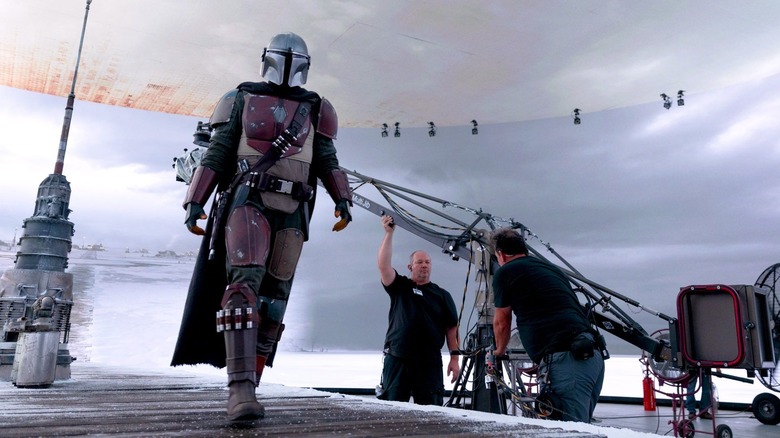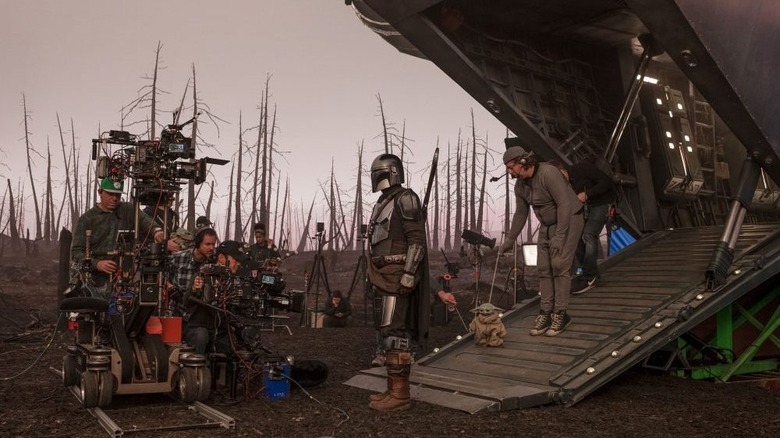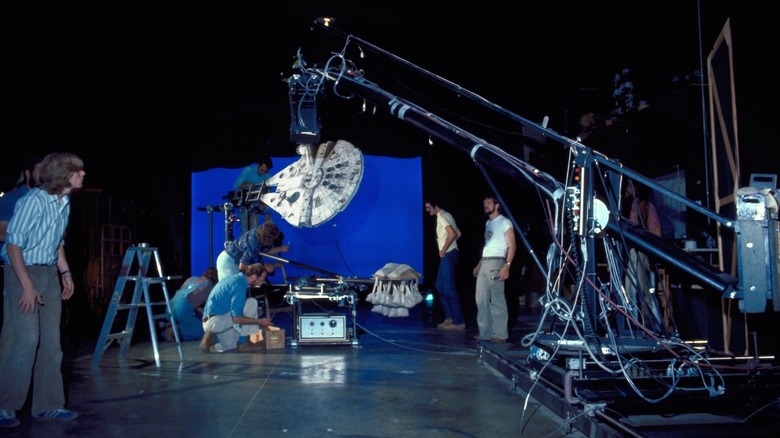How The Mandalorian Became ILM's Guinea Pig For New VFX Tech
It's still astounding to think about just how much the original "Star Wars" changed filmmaking back in 1977 when George Lucas' sci-fi fantasy adventure serial first hit theaters. Instead of waiting for technology to catch up to his ideas, Lucas surrounded himself with creative minds that managed to invent new, experimental techniques that are still being used today. Visual effects legend John Dykstra worked with a team of engineers to create the first computer-controlled motion camera called the Dykstraflex that made it possible to replicate the same shots over and over again, allowing for seamless overlays of multiple effects elements. The Dykstraflex was the key ingredient that made Lucas' vision of ships dogfighting in space a reality. Out of the need for these kinds of innovations, the legendary effects company Industrial Light & Magic was born.
From the monumental invention of the Dykstraflex to the new StageCraft technology used in "The Mandalorian," the complexity of the "Star Wars" galaxy requires the most cutting edge tools available in the industry today. To be able to make the first live action "Star Wars" television series, showrunner Jon Favreau and the entire Lucasfilm team had to essentially use the show as a test run for StageCraft to see if the idea of creating entirely virtual sets and environments would be believable on the small screen. Also referred to as "The Volume," StageCraft still has its limitations, but it's given the filmmakers the flexibility and speed they need to physically be able to make hours and hours of television over the course of three seasons.
Making the impossible possible
With "The Jungle Book" and "The Lion King," Jon Favreau has been at the forefront of new advancements in filmmaking, and he's always willing to give us a peak behind the curtain. In a chat with Film Stories, the director spoke about the early days of developing "The Volume" and how the accomplishments they've achieved have benefitted other Lucasfilm productions outside of "The Mandalorian":
"We were doing a lot of R&D with the tools for 'Lion King,' trying to figure out if we could get a camera's position to create parallax on even on a TV screen. If you look at 'Star Wars Gallery,' you'll see there's some behind-the-scenes stuff of us playing with it. We were working with a lot of different teams trying to figure out if this could be done — Magnum Opus, ILM, Unreal. Everybody knew, in theory, it could, but in order for us to film this at the speed that we needed to, we built these tools to try to accommodate our specific set of requirements."
Favreau credited Lucasfilm President Kathleen Kennedy for allowing "The Mandalorian" to budget for the necessary research and development that led to finally cracking the code for what became ILM's StageCraft. He went on to talk about some of the other tech that's helped improve existing effects. "So, we became a bit of a proving ground for that and a lot of the de-aging stuff, where we had to figure out how to make Luke [Skywalker] work," revealed Favreau. "All that stuff that is now paying off with other productions, like 'Indiana Jones.'"
Building on a legacy
Now that the technology for "The Volume" is more widely known, the entire process of creating a virtual environment may not seem as magical. But during the first season of "The Mandalorian," in particular, it was incredible to see how indistinguishable the background was from a real, physical location. However, the entire legacy of "Star Wars" has been a work in progress, and it's inevitable that sometimes audiences are going to notice that an effect isn't entirely convincing or photo-real.
That comes with the territory, and the Lucasfilm team certainly recognizes those limitations and is constantly at work trying to make improvements. When something like de-aging technology that's had issues in the past suddenly looks incredible in the trailer for "Indiana Jones and the Dial of Destiny," that's proof positive that the long line of artists that make the impossible possible are still learning and striving for more.
"You know, that's part of the tradition of 'Star Wars,'" Jon Favreau told Film Stories. "You build tools to tell stories that you otherwise can't. That's how all that motion control, miniature work, as you know, was developed, and that was how ILM was first born. George Lucas built it to serve the purpose of telling a story that otherwise couldn't be done." ILM has changed movies, and now television, forever. Assumably, the goal is to one day finally reach a point where VFX artists have the time to create stunning visual effects, and those effects can fool the human eye completely. But where will we go from there?
New episodes of "The Mandalorian" season 3 stream every Wednesday on Disney+.


